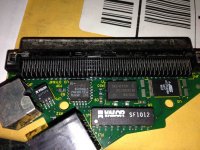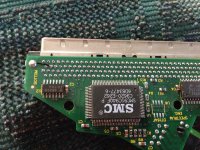A kind person gave me a Duo 210 along with a non-working (we think) Newer Technology Ethernet MicroDock a while ago. The Duo works great. I'd like to figure out if the MicroDock can be repaired.
The ADB port on it works fine, but I can't seem to get the ethernet to work. I installed the driver and it recognizes the dock, but when I plug it into a switch or hub, the link light doesn't come on and obviously no network traffic passes through. There is a self test feature you can run in their software that will test the media access control, encoder/decoder and transceiver. The media access control and encoder/decoder pass the test, but the transceiver test fails. I don't know if anything has to be plugged in for the transceiver test to pass. I'm curious if anyone else with one of these docks would know if all three tests usually pass on a working MicroDock with nothing plugged into it.
I cracked it open to look for anything obvious, but nothing really stands out. Any ideas where to even begin? Before anybody mentions it, because I know someone will, the MicroDock does not have any electrolytic capacitors


The ADB port on it works fine, but I can't seem to get the ethernet to work. I installed the driver and it recognizes the dock, but when I plug it into a switch or hub, the link light doesn't come on and obviously no network traffic passes through. There is a self test feature you can run in their software that will test the media access control, encoder/decoder and transceiver. The media access control and encoder/decoder pass the test, but the transceiver test fails. I don't know if anything has to be plugged in for the transceiver test to pass. I'm curious if anyone else with one of these docks would know if all three tests usually pass on a working MicroDock with nothing plugged into it.
I cracked it open to look for anything obvious, but nothing really stands out. Any ideas where to even begin? Before anybody mentions it, because I know someone will, the MicroDock does not have any electrolytic capacitors



